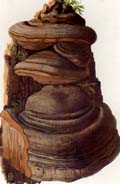Lookalikes:
 Cerrena Genus
Cerrena GenusFruiting body duplex; brown, gray or white on top; may be furry, often with algae or moss growing on it
Flesh is thin (up to 3 mm) and white.
Hymenophore starts out ivory, darkens to greyish or even black with age, and breaks up in age into separate teeth
Cryptoporus Genus
 Key to Gilled Mushrooms Key
Key to Gilled Mushrooms Key Polyporaceae Family
Polyporaceae Family Whiteoporus Tribe
Whiteoporus Tribe




